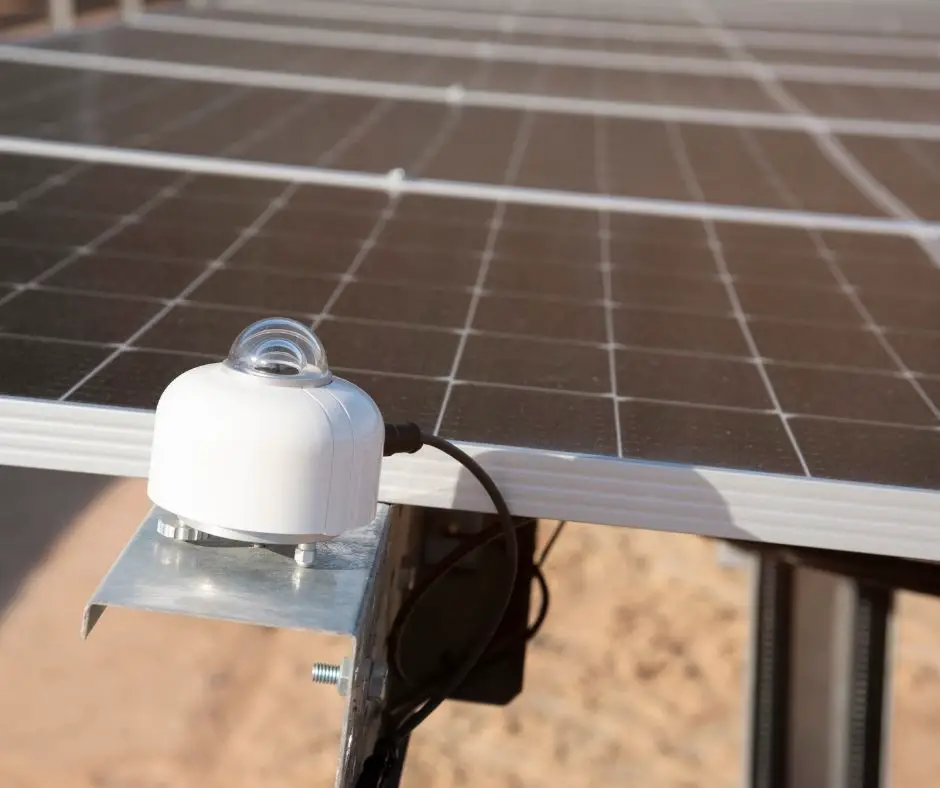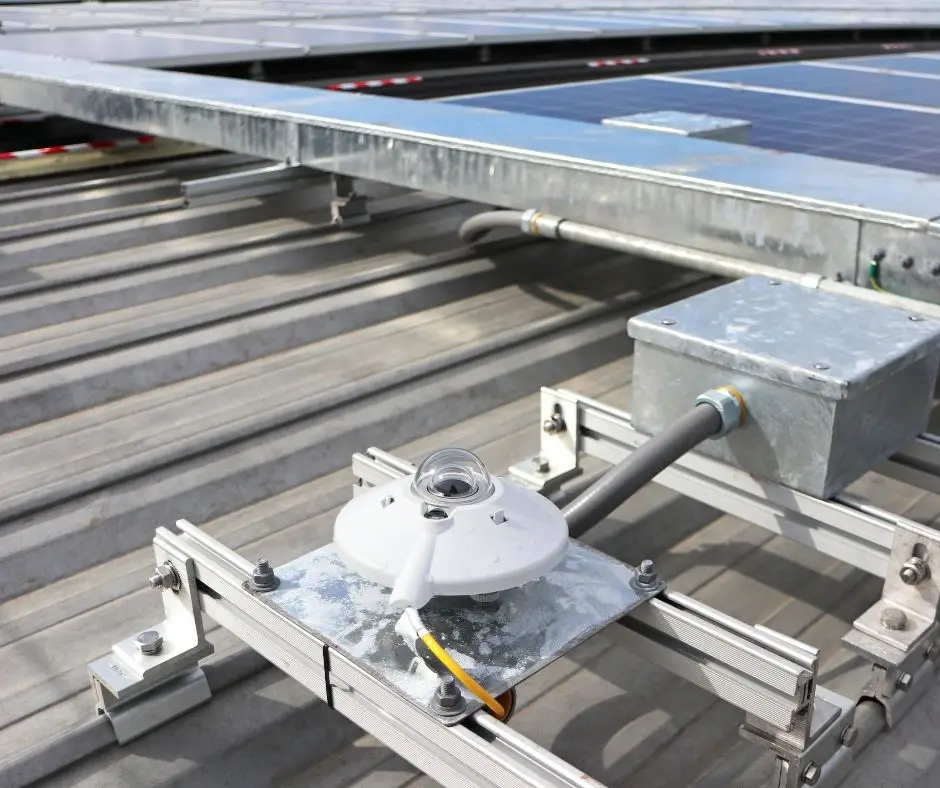The term Global Horizontal Irradiance (GHI) refers to the amount of radiant power from sunlight received by a particular surface, parallel with the Earth’s horizontal plane. It is primarily useful when monitoring a solar power plant and knowing the weather condition in a specific area at a particular time.
GHI also proves beneficial when assessing an area for the feasibility of installing a solar power system. This is done by installing a sensor to measure the irradiance data and a device that will log the values.
The unit of measurement for Global Horizontal Irradiance is in Watts per Square Meter (W/m^2). This is generally one of the values that a solar plant’s weather station will monitor along with ambient temperature, module temperature, wind speed, direct normal irradiance, diffuse normal irradiance, etc.

Introduction to Solar Plant Weather Stations
Since we are touching on the topic of GHI, it is typically common to talk about weather stations as well. As we all know, the solar PV system’s weather station monitors what the weather is like in the field.
A typical weather station is composed of the following:
- irradiance sensors
- ambient temperature sensor
- module temperature sensors
- wind speed sensor
- wind direction sensor
- data logging device
- cabling and other electronic parts
Its primary purpose is to measure the temperature, irradiance, wind speed, and other values and log them for further studies. These values can be used as a basis for the solar plant’s performance.
For example, if we see in the monitoring portal that the plant’s power output dipped, we could say that the clouds might have covered the sunlight.
It can be quickly confirmed by looking at the graph of the weather station. And also, it can be used to determine if the solar panels already need some cleaning.
Introduction to Irradiance Sensors
Solar irradiance sensors are used to measure the intensity of solar radiation falling on a surface. It is electromagnetic radiation from the sun, and it can be measured by devices such as sensors.
Solar irradiance is an essential factor in photovoltaic cell efficiency and in designing passive solar heating systems. The more we learn about solar irradiance and how it affects our planet, the more we’ll be able to create new and improved technologies and innovations.
Solar radiation is absorbed by the sensor, which produces a flat spectrum with a range of 0 to 1500 W/m^2.
These sensors detect both direct and diffuse radiation. The heat is converted from the radiation that the sensor absorbs. The heat is then transported from the sensor to the device’s casing.
The rate at which solar energy falls onto a surface is called irradiance, which is a measurement of solar power. The watt is a power measurement unit (abbreviated W).
Solar irradiance is frequently stated in W/m2, or Watts per square meter because it is generally evaluated in power per unit area.
What is GHI in a Solar Plant?
Global horizontal irradiance (GHI) is an important metric for solar energy. It is the radiant power received on a surface perpendicular to the sun’s rays. GHI is measured in watt/meter², and used as an input for photovoltaic (PV) system performance simulations.
The higher the GHI value, the more power a PV system will produce. However, it is essential to note that GHI is just one factor that determines the overall performance of a PV system; other factors such as the tilt and orientation of the PV panels also play a role.
In addition to PV systems, GHI is also used in the calculation of solar thermal collector performance. Solar thermal collectors are devices that use sunlight to heat water or another fluid. The efficiency of a solar thermal collector is determined by its ability to absorb and transfer solar energy.
The GHI value is used to calculate the amount of solar energy that is incident on the collector, and this information is used to determine the collector’s efficiency.
How To Measure the GHI Values?
GHI values can be measured using a pyranometer, which is a device that measures the amount of solar radiation received by a surface. Pyranometers are often used in conjunction with weather stations.
They can also be used to measure the amount of solar radiation received at a particular location over time. This data can be used to calculate the average GHI value for a location.
What Are the Applications Of GHI?
Global horizontal irradiance (GHI) is an important factor in many renewable energy applications. For example, GHI values can be used to determine the feasibility of solar power generation, as well as the optimal placement of solar panels.
In addition, GHI data can be used to assess the potential for solar thermal energy production. Additionally, GHI values can be used in the design of solar collectors and in the development of models to predict the output of solar power plants.
How Does a Global Horizontal Irradiance Sensor Work?
Just like any other irradiance monitoring sensor, the GHI sensor also uses the same components like a solar cell, housing enclosure, electronic circuits, and glass.
A pyranometer is a solar irradiance sensor that converts radiant power received by the unit area of the surface into a measured electrical output. Pyranometers are devices that measure a certain wavelength of the sun’s spectrum.
For example, the CMP21 Pyranometer measures wavelengths ranging from 0.285 to 2.8 m. Pyranometers are unaffected by long-wave radiation.
How Does Global Horizontal Irradiance Impact Your Life?
Solar radiation affects our everyday lives. Even though we can’t see or feel it, radiation is all around us, and it has a significant impact on our environment. There are two types of solar radiation that reach the Earth’s surface: direct and diffuse.
Direct radiation comes from the sun in a straight line and is intense. This type of radiation is responsible for heating up the Earth’s atmosphere and causing evaporation. Diffuse radiation, on the other hand, is scattered by particles in the atmosphere (such as clouds) and is not as intense.
Global horizontal irradiance (GHI) is the total amount of direct and diffuse solar radiation that hits a given area on the Earth’s surface. The amount of GHI varies depending on location, time of day, and weather conditions.
GHI has a big impact on our lives, both directly and indirectly. For example, GHI affects the amount of electricity generated from solar power plants. It also impacts agriculture, as crops need sunlight to grow.
In addition, GHI plays a role in human health, as it is a major source of vitamin D (which is vital for bone health.)
We need to be more aware of the effects of GHI in order to make better decisions that will help preserve our planet for future generations. By understanding how GHI affects our lives, we can take steps to reduce its impact and make a positive difference in the environment.
Please do not forget to sign up for our email list today! Be part of the Solar Powered Fam!





